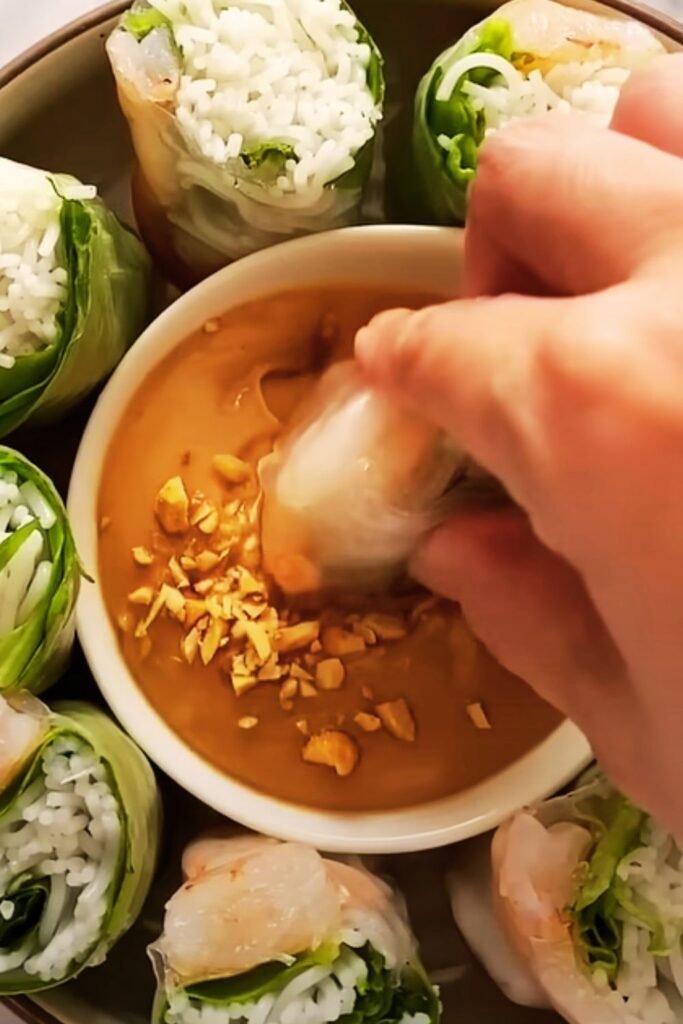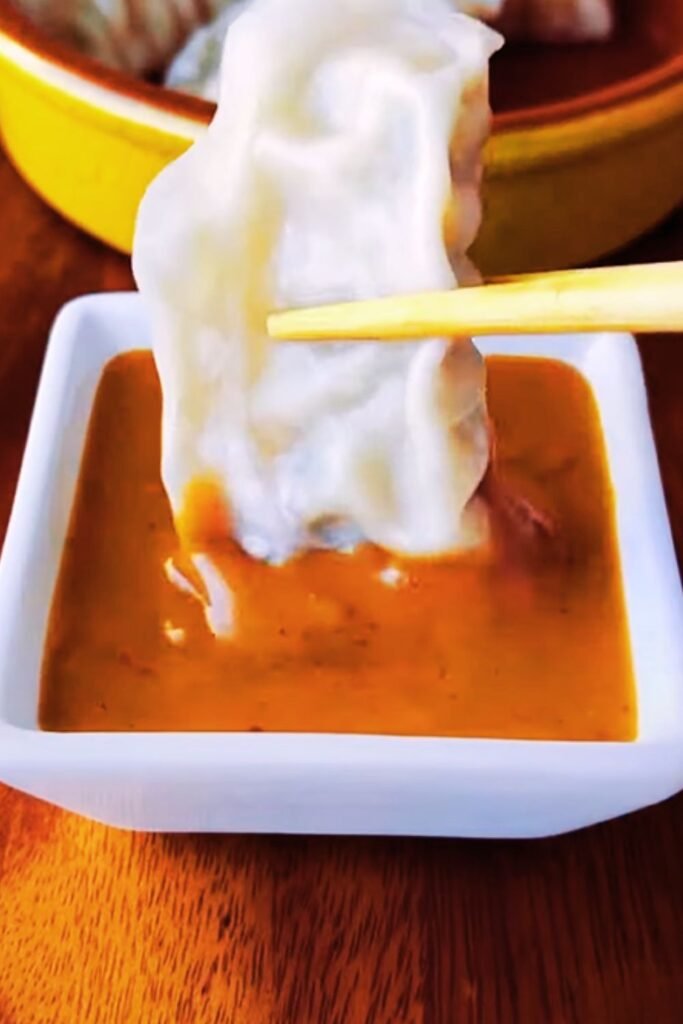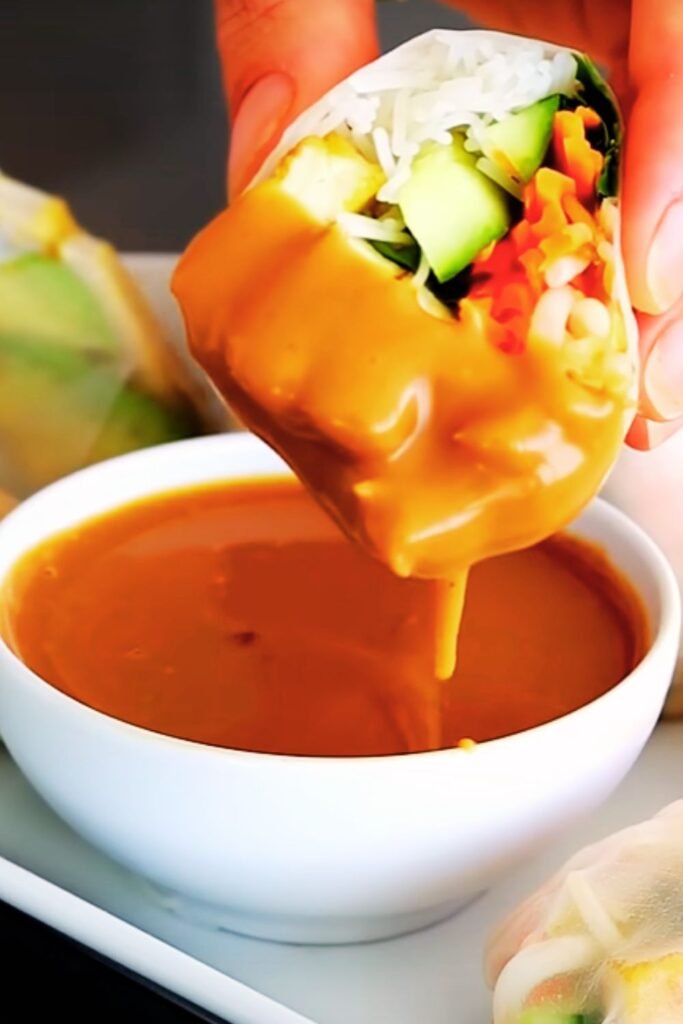I’ve been making Thai peanut sauce for over a decade, and I can confidently say it’s one of those magical condiments that transforms ordinary meals into extraordinary culinary experiences. This versatile sauce strikes the perfect balance between creamy richness, subtle sweetness, and that unmistakable spicy kick that makes your taste buds dance with joy.
When I first attempted to recreate the incredible peanut sauce from my favorite Thai restaurant, I went through countless iterations before discovering the secret lies in understanding the harmony between each ingredient. Today, I’m sharing my perfected recipe that delivers restaurant-quality results every single time, using ingredients you can easily find in most grocery stores.
What Makes This Peanut Sauce Special
My version differs from typical recipes because I focus on creating layers of flavor rather than simply mixing ingredients together. The secret lies in building the sauce gradually, allowing each component to contribute its unique characteristics while maintaining perfect balance.
Key Flavor Components:
- Creamy Base: Natural peanut butter provides richness without overwhelming sweetness
- Umami Depth: Fish sauce and soy sauce create complex savory notes
- Heat Element: Fresh chilies and sriracha deliver customizable spiciness
- Aromatic Foundation: Fresh ginger, garlic, and lemongrass add brightness
- Sweet Balance: Brown sugar and rice vinegar create harmonious contrast
Essential Ingredients Breakdown
Understanding each ingredient’s role helps you customize the sauce to your preferences and dietary needs.
| Ingredient | Amount | Purpose | Substitution Options |
|---|---|---|---|
| Natural Peanut Butter | 1/2 cup | Creamy base, protein richness | Almond butter, sunflower seed butter |
| Coconut Milk | 1/4 cup | Smooth texture, subtle sweetness | Heavy cream, whole milk |
| Soy Sauce | 3 tablespoons | Umami depth, saltiness | Tamari, coconut aminos |
| Fish Sauce | 1 tablespoon | Complex savory notes | Extra soy sauce, anchovy paste |
| Fresh Lime Juice | 2 tablespoons | Bright acidity, freshness | Lemon juice, rice vinegar |
| Brown Sugar | 2 tablespoons | Balanced sweetness | Coconut sugar, maple syrup |
| Fresh Ginger | 1 tablespoon (minced) | Warm spice, aromatic heat | Ground ginger (1 teaspoon) |
| Garlic | 3 cloves (minced) | Pungent foundation flavor | Garlic powder (1 teaspoon) |
| Sriracha | 1-2 tablespoons | Controlled heat level | Red pepper flakes, chili paste |
| Rice Vinegar | 1 tablespoon | Tangy balance | White vinegar, apple cider vinegar |
| Sesame Oil | 1 teaspoon | Nutty finish | Peanut oil, vegetable oil |
Step-by-Step Preparation Method
Creating perfect Thai peanut sauce requires patience and attention to detail. I’ve refined this process through years of experimentation to ensure consistent results.

Preparation Steps:
- Prepare Aromatics: Mince fresh ginger and garlic finely. I recommend using a microplane grater for ginger to achieve the smoothest texture possible.
- Create Base Mixture: In a medium bowl, whisk together peanut butter and coconut milk until completely smooth. This prevents lumps and ensures even distribution.
- Build Flavor Foundation: Add soy sauce, fish sauce, and lime juice to the peanut mixture. Whisk vigorously until ingredients are fully incorporated.
- Balance Sweet and Heat: Stir in brown sugar, sriracha, and rice vinegar. Taste and adjust sweetness or heat according to your preferences.
- Incorporate Aromatics: Add minced ginger and garlic, whisking until evenly distributed throughout the sauce.
- Final Touches: Drizzle in sesame oil and give everything one final whisk. The sauce should be smooth and pourable.
- Consistency Check: If the sauce seems too thick, thin with additional coconut milk or warm water, one tablespoon at a time.
Texture and Consistency Guidelines
Achieving the perfect consistency is crucial for Thai peanut sauce success. The ideal texture should coat the back of a spoon but still flow easily when poured.
Consistency Indicators:
- Too Thick: Sauce clings heavily and doesn’t pour smoothly
- Perfect: Ribbons off spoon, coats food evenly, maintains shape briefly
- Too Thin: Runs off food immediately, lacks body and richness
Adjustment Techniques:
- Thicken: Add more peanut butter gradually, whisking constantly
- Thin: Incorporate warm coconut milk or water slowly
- Smooth: Blend in food processor for silky texture
Flavor Customization Options
One reason I love this recipe is its incredible adaptability. You can modify the flavor profile to match different cuisines or personal preferences.

Heat Level Modifications:
- Mild: Reduce sriracha to 1/2 tablespoon, omit additional chilies
- Medium: Standard recipe amounts provide balanced heat
- Spicy: Add fresh minced Thai chilies or extra sriracha
- Fire: Include habanero or ghost pepper (use sparingly!)
Sweetness Adjustments:
- Less Sweet: Reduce brown sugar by half, add extra lime juice
- More Sweet: Increase brown sugar or add honey/maple syrup
- Complex Sweet: Use palm sugar or coconut sugar instead
Dietary Modifications:
- Vegan: Replace fish sauce with extra soy sauce or seaweed powder
- Keto: Use powdered erythritol instead of brown sugar
- Paleo: Substitute coconut aminos for soy sauce
- Nut-Free: Use sunflower seed butter or tahini
Storage and Shelf Life
Proper storage ensures your Thai peanut sauce maintains optimal flavor and safety for extended periods.
| Storage Method | Duration | Container Type | Temperature |
|---|---|---|---|
| Refrigerator | 7-10 days | Airtight glass jar | 35-38°F |
| Freezer | 3 months | Freezer-safe container | 0°F |
| Room Temperature | 2 hours maximum | Serving bowl | 70°F or below |
Storage Tips:
- Always use clean utensils when serving to prevent contamination
- Stir well before each use as separation is natural
- Freeze in ice cube trays for portion control
- Label containers with preparation date
Serving Suggestions and Pairings
The versatility of Thai peanut sauce extends far beyond traditional Asian dishes. I’ve discovered countless creative applications that showcase its amazing flavor profile.
Traditional Applications:
- Satay Skewers: Classic chicken, beef, or tofu satay
- Spring Rolls: Fresh or fried spring rolls with vegetables
- Noodle Dishes: Pad thai, lo mein, or rice noodles
- Stir-Fries: Any vegetable or protein stir-fry combination
Creative Modern Uses:
- Salad Dressing: Thin with extra lime juice for Asian-inspired salads
- Pizza Sauce: Replace traditional tomato sauce on flatbreads
- Sandwich Spread: Gourmet peanut butter substitute with added complexity
- Marinade Base: Tenderizes proteins while infusing incredible flavor
Protein Pairings:
- Grilled Chicken: Brush on during last minutes of cooking
- Pork Tenderloin: Excellent glaze for roasted pork
- Shrimp: Perfect dipping sauce for coconut shrimp
- Tofu: Marinate cubes before pan-frying

Nutritional Information and Health Benefits
Understanding the nutritional profile helps you incorporate this sauce into a balanced diet while maximizing its health benefits.
| Nutrient | Per 2 Tablespoons | Daily Value % |
|---|---|---|
| Calories | 145 | 7% |
| Total Fat | 12g | 15% |
| Saturated Fat | 3g | 15% |
| Sodium | 580mg | 25% |
| Total Carbs | 8g | 3% |
| Dietary Fiber | 2g | 7% |
| Sugars | 5g | – |
| Protein | 5g | 10% |
Health Benefits:
- Heart-Healthy Fats: Monounsaturated fats from peanuts support cardiovascular health
- Protein Content: Plant-based protein helps maintain muscle mass
- Antioxidants: Ginger and garlic provide anti-inflammatory compounds
- Vitamin E: Peanuts contribute significant vitamin E for skin health
Nutritional Considerations:
- High sodium content requires moderation for those watching salt intake
- Natural sugars provide quick energy without refined sugar spikes
- Healthy fats increase satiety and nutrient absorption
Troubleshooting Common Issues
Through years of teaching this recipe, I’ve encountered every possible problem and developed solutions for each situation.
Problem: Sauce is Too Thick
- Cause: Insufficient liquid or over-mixing peanut butter
- Solution: Add warm coconut milk gradually while whisking
- Prevention: Measure liquids carefully, use natural peanut butter
Problem: Grainy Texture
- Cause: Brown sugar not fully dissolved or cold ingredients
- Solution: Warm sauce gently while stirring to dissolve crystals
- Prevention: Use room temperature ingredients, dissolve sugar in liquid first
Problem: Lacks Flavor Depth
- Cause: Insufficient fish sauce or aromatics
- Solution: Add more fish sauce gradually, increase ginger and garlic
- Prevention: Taste frequently during preparation, adjust seasoning
Problem: Too Salty
- Cause: Excessive soy sauce or fish sauce
- Solution: Balance with additional brown sugar and lime juice
- Prevention: Start with less sodium-containing ingredients, build gradually
Advanced Techniques and Pro Tips
After perfecting this recipe, I’ve developed several professional techniques that elevate the final result significantly.
Temperature Management:
- Slightly warm ingredients blend more smoothly than cold ones
- Never heat peanut butter directly as it can seize and become grainy
- Room temperature sauce has better flavor release than chilled
Ingredient Quality Impact:
- Natural peanut butter without added oils produces superior texture
- Fresh-squeezed lime juice provides brighter acidity than bottled
- High-quality fish sauce adds complexity without overwhelming fishiness
Mixing Techniques:
- Whisk in figure-eight motions to prevent air bubbles
- Add liquid ingredients gradually to maintain emulsion
- Final stirring should be gentle to preserve smooth texture
Flavor Development:
- Allow sauce to rest 30 minutes before serving for flavors to meld
- Taste and adjust seasoning after resting period
- Consider making day ahead for deepest flavor development
Frequently Asked Questions
Q: Can I make this sauce without fish sauce? Yes, you can substitute fish sauce with additional soy sauce or a vegetarian fish sauce alternative. I recommend adding a small amount of seaweed powder or miso paste to replicate the umami depth that fish sauce provides.
Q: How do I prevent the sauce from separating? Separation occurs when ingredients are at different temperatures or when oil-based components aren’t properly emulsified. Always use room temperature ingredients and whisk thoroughly when combining. If separation occurs, re-whisk vigorously or blend briefly.
Q: Can I use crunchy peanut butter instead of smooth? While smooth peanut butter creates the traditional silky texture, crunchy peanut butter adds interesting texture contrast. If using crunchy, you may need slightly more liquid to achieve proper consistency.
Q: How spicy is this sauce on a scale of 1-10? With the standard sriracha amount, I’d rate this sauce a 4-5 out of 10. The heat is noticeable but not overwhelming, making it suitable for most palates. You can easily adjust the spice level to your preference.
Q: What’s the best way to thin the sauce for salad dressing? For salad applications, thin the sauce with equal parts lime juice and warm water. Start with 2 tablespoons of each and adjust until you achieve a pourable consistency that still coats lettuce leaves effectively.
Q: Can I freeze this peanut sauce? Yes, Thai peanut sauce freezes well for up to three months. Freeze in ice cube trays for convenient portions, then transfer to freezer bags. Thaw in refrigerator and whisk well before using, as some separation may occur.
Q: Why does my sauce taste bland compared to restaurant versions? Restaurant peanut sauces often have higher sodium content and use MSG for enhanced umami flavor. Try increasing fish sauce gradually and ensure you’re using fresh aromatics. Also, allowing the sauce to rest develops deeper flavors.
Q: Can I use this sauce as a marinade? Absolutely! This sauce works excellently as a marinade for chicken, pork, or tofu. Marinate proteins for 2-4 hours maximum, as the acidity can start to “cook” the meat if left too long.
Q: What should I do if the sauce is too sweet? Balance excessive sweetness by adding more lime juice, rice vinegar, or a small amount of additional fish sauce. These acidic and salty components will counteract the sweetness without overpowering other flavors.
Q: How do I know when the consistency is perfect? Perfect Thai peanut sauce should coat the back of a spoon but still drip off slowly. When you dip a piece of food into it, the sauce should cling nicely without being too thick or running off immediately.
This Thai peanut sauce recipe represents years of refinement and testing, resulting in a versatile condiment that brings authentic flavors to your kitchen. The balance of sweet, spicy, and savory elements creates a sauce that complements countless dishes while remaining true to traditional Thai flavors. Whether you’re hosting a dinner party or preparing a simple weeknight meal, this sauce elevates any dish it touches with its complex, satisfying taste profile.